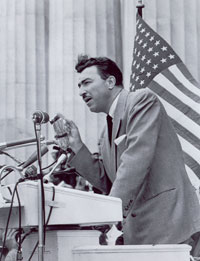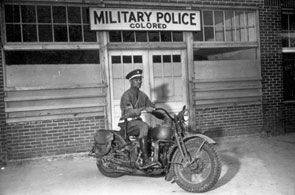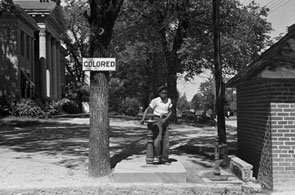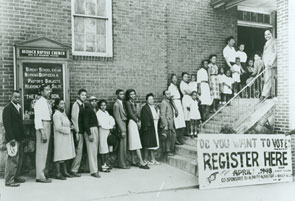Keeping the Faith
African Americans Return to Congress, 1929–1970
Introduction
 Adam Clayton Powell, Jr., of New York, a charismatic and determined civil rights proponent in the U.S. House, served as a symbol of black political activism for millions of African Americans.Image courtesy of Library of Congress
Adam Clayton Powell, Jr., of New York, a charismatic and determined civil rights proponent in the U.S. House, served as a symbol of black political activism for millions of African Americans.Image courtesy of Library of CongressWith his election to the U.S. House of Representatives from a Chicago district in 1928, Oscar De Priest of Illinois became the first African American to serve in Congress since George White of North Carolina left office in 1901 and the first elected from a northern state. But while De Priest’s victory symbolized renewed hope for African Americans struggling to regain a foothold in national politics, it was only the beginning of an arduous journey. The election of just a dozen more African Americans to Congress over the next 30 years was stark evidence of modern America’s pervasive segregation practices.
The new generation of black lawmakers embarked on a long, methodical institutional apprenticeship on Capitol Hill. Until the mid-1940s, only one black Member served at any given time; no more than two served simultaneously until 1955. Arriving in Washington, black Members confronted a segregated institution in a segregated capital city. Institutional racism, at turns sharply overt and cleverly subtle, provided a pivotal point for these African-American Members—influencing their agendas, legislative styles, and standing within Congress. Pioneers such as Adam Clayton Powell, Jr., of New York, Charles C. Diggs, Jr., of Michigan, and Augustus (Gus) Hawkins of California participated in the civil rights debates in Congress and helped shape fundamental laws such as the Civil Rights Act of 1964. For the first time, African Americans made substantive, not merely symbolic, gains within the institution. William L. Dawson of Illinois and Representative Powell became the first blacks to chair standing congressional committees. Eight of these trailblazers would eventually lead one or more standing House committees.
Demographic shifts continued to transform the black political base during these decades, fundamentally recasting the background and experiences of black Members of Congress. None of the black Members from this period represented a southern district or state—a testament to the near-complete disfranchisement of southern blacks and a massive, decades-long migration of millions of African Americans employed in agricultural work in the South to urban areas in the North in search of industrial jobs. While their representation of northern cities alone would have distinguished this group of black Members from their Reconstruction-Era predecessors, they were also overwhelmingly Democratic, sharply contrasting with the uniformly Republican 19th-century African Americans in Congress. New Deal reforms providing a modicum of economic relief—and, more compellingly, the promise of fuller participation in American life—drew Black Americans away from the party of Lincoln and into a durable Democratic coalition built by President Franklin D. Roosevelt. With the exception of De Priest and Senator Edward Brooke of Massachusetts, all the black Members of Congress from this era were Democrats.
An atomistic individualism characterized the careers of African-American congressional pioneers in the early decades of this era. The burden of advocating black interests fell on the shoulders of a few Representatives: De Priest and Arthur Mitchell of Illinois in the 1930s and Powell and Dawson in the 1940s, joined by Diggs and Robert Nix of Pennsylvania in the 1950s. Seven of the 13 individuals to serve in this era were not elected until the 1960s, just as the civil rights movement led by Reverend Martin Luther King, Jr., crested and compelled the federal government to enact legislative reforms. Yet this cohort formed a political vanguard that, in many respects, mirrored the experiences and trends reconfiguring black participation in modern American politics. Brooke—the first black U.S. Senator since Blanche Bruce of Mississippi during Reconstruction—entered the upper chamber in 1967; two years later, Representative Shirley Chisholm of New York became the first black woman tosere in Congress.
Like their Reconstruction-Era predecessors, these African-American Members endured racist slurs and prejudicial slights that complicated their development as legislators. Too few to effect change as a voting bloc within Congress, they acted either as public advocates commanding the spotlight on behalf of racial equality or as patient insiders who sought to deliver economic and political benefits to black constituents by accruing influence within the existing power structure. Yet the symbolism of this handful of black congressional careers initiated between the onset of the Great Depression and the social ferment of the late 1960s far exceeded the sum of its parts. Arguably for the first time, Black Americans who sent Members to Capitol Hill were substantively rewarded with legislative efforts made expressly on their behalf. “Keep the faith, baby,” Representative Powell famously intoned, “spread it gently and walk together, children.”1 His oft-repeated words captured the essence of African Americans’ growing collective political activism.
Pre-Congressional Experience
 Nearly one million blacks served in World War II, most in the segregated U.S. Army. This 1942 picture of a military policeman astride his motorcycle on a base in Columbus, Georgia, underscored the reality that Jim Crow practices prevalent in civilian life were also a part of military service.Image courtesy of National Archives and Records Administration
Nearly one million blacks served in World War II, most in the segregated U.S. Army. This 1942 picture of a military policeman astride his motorcycle on a base in Columbus, Georgia, underscored the reality that Jim Crow practices prevalent in civilian life were also a part of military service.Image courtesy of National Archives and Records AdministrationNumerous parallels can be drawn between the black Congressmen of the Reconstruction Era and the 13 African Americans who were elected to Congress between 1929 and 1970. Many were born in the South, some into well-to-do circumstances. All were well educated, especially compared to the general population, and they drew from a growing reserve of political experience. Like most of their white congressional colleagues, 20th-century black Members of Congress tended to be selected from the elite of their communities. Each had bridged the gulf that separated blacks from the opportunities enjoyed by better-educated, more-affluent whites. A leading political scientist notes that “in terms of education, income, and occupation, these black representatives resemble their white counterparts more than they do their African-American constituents.”2
Six of the blacks elected to Congress from 1929 to 1970 were born into racially segregated circumstances in the South.3 Some participated in the Great Migration to northern and western urban areas with their parents (or, later, as young adults), attracted by better economic, social, and cultural opportunities.4 Born in Florence, Alabama, Oscar De Priest was 7 when his family joined the 1878–1879 exodus of some 60,000 black families from the Lower Mississippi Valley to Kansas; he eventually moved to Chicago as a young man. His successor, Arthur Mitchell, was born in Lafayette, Alabama, and taught school in the South before attending northern colleges to earn his law degree, eventually settling in Chicago in the 1920s—a decade when nearly 750,000 blacks moved to the North. William Dawson, who succeeded Mitchell, was born in Albany, Georgia, and attended school in the South before moving to Chicago prior to World War I. It was not until mid-century that the first black Members of Congress were elected to represent the cities where they were born and raised. These included Charles Diggs of Detroit (1954), John Conyers, Jr., of Detroit (1964), Louis Stokes of Cleveland (1968), William L. Clay, Sr., of St. Louis (1968), Shirley Chisholm of Brooklyn (1968), and George W. Collins of Chicago (1970).
Service in the U.S. Army played a formative role in the lives of a majority of these Members of Congress.5 For those born in the North, the military was a brusque introduction to blatantly segregationist practices. Both Diggs and Stokes, who were stationed in the Deep South, recalled instances of discrimination when African-American soldiers were refused food service, while white GIs and German prisoners of war dined together. “That was the shock of recognition to me, that an enemy was more welcome than a black,” Diggs observed.6 That experience sparked Diggs’s future political commitment to securing equal rights for African Americans. Shortly after taking office in 1943, William Dawson, who had graduated from the country’s first black officers’ candidate school in 1917, declared, “I know what segregation in the army means… is a damnable thing anywhere and I resent it.”7 As a Member of Congress during World War II, Dawson was a vocal proponent of integrating U.S. forces and, in 1944, when Secretary of War Henry L. Stimson suggested that black soldiers were unfit for combat duty, Dawson demanded his removal.8 Edward Brooke, who served during World War II in Europe in the segregated 366th Combat Infantry Regiment and later in the 224th Engineering Battalion, recalled, “The prejudice Negro soldiers faced in the army was underscored by the friendliness of the Italians, who were colorblind with regard to race…It was maddening to be given lectures on the evils of Nazi racial theories and then be told that we should not associate with white soldiers or white civilians.”9 After being drafted in 1953, five yearsafter the services were integrated by presidential order, William Clay, Sr., was stationed at Fort McClellan in Alabama—an army post that was still largely segregated, in Clay’s words, “with all the insobriety of the last Confederate general and the insolence of the last Confederate infantryman.” Clay organized a boycott against the segregated barbershop, a whites-only Post Exchange restaurant, and a segregated swimming pool. Later, Representative Diggs launched an investigation into base practices at Fort McClellan.10
Like their Reconstruction predecessors, 20th-century black political pioneers in Congress were exceedingly well educated—eclipsing the educational level of the average American and far surpassing the educational level of their fellow Black Americans.11 All graduated from high school. Only one, De Priest, did not receive at least a partial college education; seven studied law at elite historically black institutions and Ivy League schools. As organs of political protest and racial advancement, African-American churches played a central role in the larger civil rights movement of the 1950s and 1960s, but religious studies and service in the pulpit were not a prerequisite for black Members of Congress. Among these black Members, only Adam Clayton Powell, who succeeded his father as pastor of New York’s Abyssinian Baptist Church, was trained in the ministry.
Political opportunities were more often secular. The majority of the African Americans elected to Congress during this period had experience in elective office. Five served on city councils in major urban areas as a result of the growing population and influence of blacks in northern cities: De Priest, Dawson, and Collins served in Chicago, Powell served in New York City, and Clay served in St. Louis. Diggs, Hawkins, and Chisholm served in state legislatures. Edward Brooke served two terms as Massachusetts attorney general, becoming one of the highest-ranking African-American law enforcement officials in history.12 Only Stokes, Nix, and Conyers won election to the House without having held an elective office, but all three had extensive local political experience.13 Reflecting inroads made by the modern women’s rights movement, gender diversity became a reality for Black Americans in Congress during this era.14 In 1968, Shirley Chisholm won a newly redistricted seat in Brooklyn, becoming the first African-American woman elected to Congress. She ran against James Farmer, a famous civil rights activist nominated as the Liberal-Republican candidate partly because he argued that the Democrats had for too long “thought they had [the black vote] in their pockets.” Chisholm and Farmer staked out similar economic and social positions, and their campaigns were nearly identical, but Farmer argued that women had been “in the driver’s seat” in black communities for an extensive period and that the district needed “a man’s voice in Washington.”15 Chisholm prevailed, becoming an overnight symbol of crumbling barriers for blacks in national political office. Within five years, Yvonne Brathwaite Burke of California, Barbara Jordan of Texas, and Cardiss Collins of Illinois joined her in the House. “The black man must step forward,” Chisholm was fond of saying, “but that doesn’t mean that black women have to step back.”16
Footnotes
- Thomas A. Johnson, “A Man of Many Roles,” 5 April 1972, New York Times: 1.
- Carol Swain, “Changing Patterns of African-American Representation in Congress,” in The Atomistic Congress: An Interpretation of Congressional Change, Allen D. Hertzke and Ronald M. Peters, Jr., eds., (Armonk, NY: M. E. Sharpe, 1992): 107–140; quotation on page 118.
- Aside from De Priest, Mitchell, and Dawson, the group included Robert Nix, Augustus Hawkins, and Edward Brooke.
- See the discussion about the Great Migration in the preceding contextual essay, “The Negroes’ Temporary Farewell.” For more on black migrations in the post-Reconstruction period and the 20th century, see Nicholas Lemann, The Promised Land: The Great Black Migration and How It Changed America (New York: Knopf, 1991); Nell Irvin Painter, Exodusters: Black Migrants to Kansas After Reconstruction (Lawrence: University Press of Kansas, 1986); James R. Grossman, Land of Hope: Chicago, Black Southerners, and the Great Migration (Chicago: University of Chicago Press, 1989) and Joe William Trotter, Jr., ed., The Great Migration in Historical Perspective: New Dimensions of Race, Class, and Gender (Bloomington: Indiana University Press, 1991).
- One served in World War I, four served in World War II, one saw combat in Korea, and another was drafted into service in the 1950s. Four were officers (Dawson, Brooke, Diggs, and Conyers); the rest were enlisted men. For an overview of the black experience in the military, see Bernard Nalty, Strength for the Fight: A History of Black Americans in the Military (New York: Free Press, 1986). For another assessment, see Robert W. Mullen, Blacks in America’s Wars: The Shift in Attitudes from the Revolutionary War to Vietnam (New York: Monad Press, 1973).
- “Former Congressman Diggs Enters Prison,” 24 July 1980, Associated Press.
- Harry McAlpin, “Dawson Takes Seat in House, Tells Plans,” 16 January 1943, Chicago Defender: 9; see also Denton J. Brooks, Jr., “Fame Brings Dawson Chance to Help Race,” 3 April 1943, Chicago Defender: 13.
- Denton J. Brooks, Jr., “Dawson Demands Stimson’s Removal,” 4 March 1944, Chicago Defender: 1.
- Edward Brooke, Bridging the Divide: My Life (New Brunswick, NJ: Rutgers University Press, 2007): 33.
- William L. Clay, Bill Clay: A Political Voice at the Grass Roots (St. Louis: Missouri Historical Society, 2004): 16.
- To put these accomplishments into perspective, by 1970 just 4.6 percent of black men and 5.1 percent of black women earned college degrees compared to 16.1 percent of white men and 9.5 percent of white women. An astounding 66.4 percent of all black males (66.7 percent of black women) in 1970 did not earn a high school diploma. These percentages were even lower in 1930 for both races and sexes and slowly increased each decade through 1970. Thus, the educational achievements of the black Representatives elected early in the period are all the more remarkable. See “College Graduation Rate, by Sex, Nativity, and Race: 1940–1997” and “High School Non-Completion Rate, by Sex, Nativity, and Race: 1940–1997,” in Historical Statistics of the United States, Volume 2: Work and Welfare, Susan Carter et al., eds. (New York: Cambridge University Press, 2006): 469–470.
- Former U.S. Representative Robert Elliott, a South Carolina Republican, was elected state attorney general in the 1876 election that swept Democrats back into power. He was forced from office in May 1877 under pressure from the administration of Governor Wade Hampton. For more on this episode, see Peggy Lamson, The Glorious Failure: Black Congressman Robert Brown Elliott and the Reconstruction in South Carolina (New York: W. W. Norton & Company, Inc., 1973): 250–270.
- Stokes’s brother and political mentor, Carl, served in the Ohio legislature and became the first African-American mayor of a major city (Cleveland) in 1967. It was Carl who convinced Louis to run for a newly drawn majority-black district in Cleveland. Nix was appointed as a deputy attorney general in Pennsylvania and also served as a Democratic committeeman in Philadelphia for 26 years, eight as chairman. Conyers worked as a legislative aide to U.S. Representative John Dingell, Jr., of Michigan, served as counsel to labor union locals, and received gubernatorial and presidential appointments before winning election to the House. As of December 31, 2007, Conyers, first elected in 1965, was the second-longest-serving current House Member: Dingell, who succeeded his father in 1955, was the longest-serving current House Member.
- For the impact of the women’s rights movement on Representatives, see Office of History and Preservation, U.S. House of Representatives, Women in Congress, 1917–2006 (Washington, DC: Government Printing Office, 2007): 324–343.
- John Kifner, “G.O.P. Names James Farmer for Brooklyn Race for Congress,” 20 May 1968, New York Times: 34; John Kifner, “Farmer and Woman in Lively Bedford-Stuyvesant Race,” 26 October 1968, New York Times: 22. See also Shirley Washington, Outstanding Women in Congress (Washington, DC: U.S. Capitol Historical Society, 1995): 17. Farmer echoed the findings contained in a controversial report produced by sociologist Daniel Patrick Moynihan (later a U.S. Senator from New York) titled The Negro Family: The Case for National Action (1965). The Moynihan Report, as it was later called, argued that the deteriorating black family structure seriously impeded the advancement of the race. More pointedly, the report suggested that a matriarchal structure in the black community undercut black men’s roles as authority figures.
- Susan Brownmiller, “This Is Fighting Shirley Chisholm,” 13 April 1969, New York Times: SM32; see also Fred L. Zimmerman, “Negroes in Congress: Black House Members Will Add to Their Ranks in the Next Few Years,” 22 October 1968, Wall Street Journal: 1.


